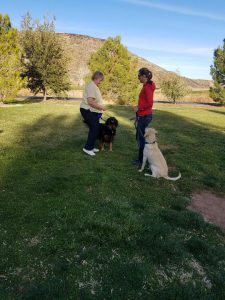Needy Dog Behavior
What is needy dog behavior? It presents in many forms. But first let’s talk about what we mean by a needy dog. The needy dog may follow you everywhere and demand your attention. In the house he will follow you from room to room, often even wanting to join you in the bathroom! He may want to be physically close to you or touching you at all times. He may demand attention by whining, barking, pawing or staring at you.
A Needy Dog Needs Something
As the phrase “needy dog” implies, the dog feels he needs something. A close connection to you, attention, petting, a game– something. Some dogs can be very demanding about their needs, and can therefore be quite hard to live with.
I went online to see what others have said about needy dogs, and what owners felt about their dog’s needy or clingy behavior. I was surprised that although this seems to be something many are concerned about, few addressed where the behavior comes from–in other words why the dog is needy.
Why Is My Dog Needy? Is It A Bad Thing?
There are as many answers to this question as there are needy dogs! But I think needy dogs that are demanding fall into 2 general categories. First would be dogs who have anxiety or have not received enough or proper attention from humans. The second are dogs who have been reinforced (usually unintentionally) for demanding or clingy behaviors by their people.

There are also dogs who may be considered needy, in that they want that closeness at all times, but that aren’t pushy or demanding. For these dogs this is a personality trait, but not a problem at all. A dog can want a connection with their person at all times, but be polite and not demanding. These dogs are better adjusted to their wish to be with their human, so they don’t need to be pushy or they have learned that pushiness doesn’t work. If your dog wants to be close to you at all times, but doesn’t have behaviors you find annoying, very good. If this dog can’t handle being left alone when you leave home, that is another separate (often, but not always, related) topic.
Dogs With Wishes, Maybe Needs.
Dogs wish for attention, companionship, interaction, physical and mental stimulation. Many dogs get a lot of these things, but by demanding more (whining, barking, pawing, etc.) they have learned they can get even more. If we respond to our dog’s demands by talking to them, petting them, throwing that ball one more time, etc. we actually develop and encourage our dog’s needy and/or pushy behavior. These dogs wish for more, and may or may not genuinely need more.
Dogs With Genuine Needs, Not Just Wishes
Many dogs have not gotten the love and attention all dogs need. When we rescue a dog, we often don’t know their backgrounds. Just the process of loosing a home and moving to another can cause insecurity, and a need for reassurance that love and attention are there and are always going to be there.
Even dogs in a home where they are loved may not be given the attention and structure they need. We are often busy with many things (jobs, children, hobbies, other pets, human relationships, etc,) and don’t realize our dogs are feeling left out or understimulated mentally, physically or emotionally. These dogs often develop demanding or clingy behaviors because they desperately need more.

Ask Your Dog “What Do You Need?”
Before we get into stopping the unwanted needy behavior, ask yourself and your dog “What is missing?”. Does your dog get lots of love and attention? And is it attention he actually wants? Young children crawling all over the dog, lying on the dog, hugging the dog are often things that a dog may tolerate, but few actually enjoy (why so many young children get bitten). Training sessions with orders in a sharp voice and corrections for mistakes are rarely things the dog truly enjoys, and may actually increase the dog’s anxiety. Being on the outside looking in (out in the yard, in a crate, behind a gate) may be fine for what is going on, but can’t be counted as interaction or attention. Your dog needs to feel secure and valued.
He needs attention that he truly enjoys. He needs mental stimulation (stress free training, walks outside his yard, puzzle toys, games, etc.). He also needs physical stimulation (off leash walks when appropriate, active games, play with other dogs). He needs structure and consistency so he knows what to expect.
You need to meet your dog’s needs, and then you can work on getting rid of the demanding behaviors you don’t like.
You May Have Trained Your Dog’s Demand Behavior!
Otherwise known as: Your dog has trained you to respond to his annoying behavior by your doing what he wants! So how do we get rid of the behavior that we don’t want?
First, and I can’t stress this enough, be sure your dog is getting love, attention, mental and physical stimulation. Then, ignore the behaviors you don’t like. If your dog doesn’t get reinforcement for those behaviors, he will give them up.
Keep in mind that paying attention to those annoying demands, even with pushing the pawing foot away, or telling the dog “get off” or “stop it” can be very reinforcing for dogs. Many dogs think it’s better to be fussed at and pushed away than be ignored!
Ignore Or Walk Away From Unwanted Behavior

Your dog paws at you for attention. Ignore it, or just get up and walk away whenever he does it. Yes, it is frustrating at first. You want to sit and read, not get up and walk away. It is worth it though, if you don’t like getting pawed at.

Your dog barks at you for you to throw his ball again, or for you to pay attention to him. Again, ignore it. Or get up and walk away. It may take awhile, but your dog will learn that barking at you to demand things doesn’t work.
When I’m done playing ball with my dogs, I say “all done” and stick to it. If they beg for one more throw, I just repeat “all done”. If my dog kept pushing me to play, I would put the ball away where the dog didn’t have access to it.
In the house, my dogs have access to their toys and balls. If they bring me a ball, I’ll say “nope” if I don’t want to play, and stick to it. They know pestering me won’t work, so they don’t. If I want to play I do, usually going outside as I don’t want to encourage a lot of play with me in the house. Many people want to play in the house, especially with small dogs or in apartments. No problem! But have a cue that ends the play session (I use “all done”) and stick to it.
Mouthing or play biting past young puppyhood can be really annoying. I may give the dog something more appropriate to put in his mouth–such as a chew toy. But if he keeps mouthing me or tries to use me as a chew toy, I turn away as soon as the dog puts his mouth on me, or walk away. Go out of the room for a minute whenever the dog puts his mouth on you. When he makes the connection; Mouth on person, lose access to person, he’ll give it up. You don’t need to leave for long, it is seeing you leave when he mouths that gets the point across. When you come back in, if he mouths, leave again.
In conjunction with this, I will divert his attention from mouthing with a short training session. Many puppies get into biting and mouthing when they are too wound up. I find owners then try to play and get the energy out. I am certainly not discouraging play and exercise! But when pups get wound up too much, they have trouble bringing themselves down to a calmer state. At this point, reviewing some training the puppy knows (sit, down, whatever), with treat rewards, will change his focus and allow him to calm down.
Teach An Alternate Behavior
Sometimes teaching an alternate behavior works better than ignoring what you don’t like. A great example of this is the dog that jumps on you or other people. Turning away when the dog jumps and giving attention when he is “four on the floor” works for many dogs.
If your dog has been practicing jumping for awhile, ignoring it may not be enough! Asking for a behavior that is incompatible with jumping up works well.
I like a “sit”. First teach the dog to sit, if he doesn’t already know the cue. Then ask for a sit when the dog is in a situation that is likely to have him jumping (excitement, coming home, greeting people, etc.).

I try not to use food rewards or toy rewards for this once the dog understands the sit cue, because the dog will quickly learn “Jump, get asked to sit, get reward”. So I prefer to use petting, praise, interaction rather than treats. Consistency is important! If your dog gets petted (rewarded) sometimes when he jumps, he will continue trying jumping up for attention!
In Conclusion
If your dog has annoying demand behaviors, first ask yourself if your dog is getting what he needs. Love, affection, attention, exercise, mental stimulation are all essential to have an emotionally stable dog.
Then ignore or walk away from the demand behaviors you don’t like. Dogs don’t practice (repeat) behaviors that don’t get them something. If being pushy gets the dog attention, even negative attention, he will keep repeating it.
Be mindful of your actions around your dog, and you will notice how you reinforce behaviors you don’t really like. Once you are aware of your actions, you can modify them to have that polite dog that is easy to live with!

A basic principle of living with dogs is reward behavior you like and it will be repeated, ignore behavior you don’t like and it will disappear.
Let Us Know Your Experiences
Have you worked on eliminating demand behaviors? What has worked for you? Leave a comment here if you want to tell us your ideas or situation. Need more help? Feel free to ask, by leaving a comment or emailing me directly at keith@goodtimesdogtraining.com.
Thanks for the post. I am so busy with the kids these days it didn’t really occur to me that our four legged friend might not have adjusted to the change of having kids in the house. A great reminder, maybe I’ll try some kid free walks 🙂
Sounds like a great idea. Both you and your dog would probably appreciate the break!
Great article, I learned alot from our training sessions over the years, patience is the key to success and it sure is difficult with a chi, I walk away alot!
Hi Mileen,
Thanks for your comment. So many people don’t teach little dogs manners or basic training, so they behave poorly. I love that you work on their manners.
As you rescue small dogs with severe behavior problems, you have a real challenge in teaching them polite behaviors. I love that you work on it, and I have seen the successes you have.
Keep up the good work!!! Keith